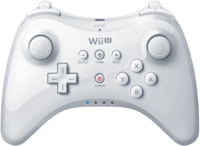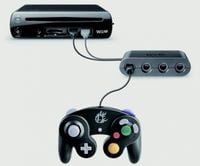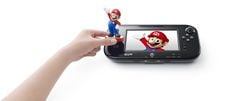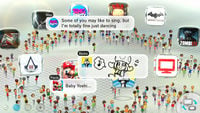Wii U: Difference between revisions
No edit summary |
(Undo revision 2125383 by 98.4.17.246 (talk) I see no talk page discussion about this.) |
||
| Line 4: | Line 4: | ||
|Dis=N/A | |Dis=N/A | ||
|Pre=[[Wii]] | |Pre=[[Wii]] | ||
|Suc= | |Suc=<includeonly> THE SWITCH HAS YET TO BE CONFIRMED AS THE WII U'S SUCCESSOR. </includeonly> N/A | ||
|ratings= | |ratings= | ||
}} | }} | ||
Revision as of 22:58, January 29, 2017
Template:System-Infobox Template:LLQuote
The Wii U is an eighth generation home console produced by Nintendo as the successor to the Wii. It was announced during Nintendo's conference at E3 2011. The main feature of the Wii U is its controller, the Wii U GamePad, which has a touch screen, camera, and other new features. According to Yoshiaki Koizumi, the Wii U was never shown to Nintendo's software development team prior to its unveiling at E3 2011. The Wii U was the third Nintendo console to be released in North America before Japan, the other two being the Wii and Nintendo DS.
Features
The Wii U console resembles the Wii, except is much longer with rounder sides. It has a slot to insert 12-centimeter proprietary high-density optical discs as well as the Wii's DVD optical discs. The console can play high-definition games at 720p and 1080p, the first of Nintendo's consoles to do so. The console itself is approximately 4.6 cm tall, 17.3 cm wide, and 26.7 cm long. When placed horizontally, it slightly resembles the Wii Family Edition.
The Wii U supports all the controllers (and respective peripherals) used with the Wii: the Wii Remote, the Nunchuk controller, the Wii Remote Plus, the Classic Controller, the Classic Controller Pro, and the Wii Balance Board. It is compatible with the Wii hardware and software, but, similar to the Wii Family Edition, it is not compatible with the Nintendo GameCube hardware or software.[1]
The Wii U supports up to eight-player local play, as seen in Super Smash Bros. for Wii U. It can support up to two GamePads, a feature not yet used for any games, though the Wii U GamePad is not currently sold at retail. The console has an internal flash memory, holding 8 GB for the standard set, and 32 GB for the deluxe set. Additionally, the Wii U has the option to expand its memory by using an external USB hard disk drive, however, even though the Wii U has an SD Card slot, SD Cards cannot be used for Wii U data storage (excluding Mii storage), though they can be used for storing Wii data via the Wii Menu only. This also means that Wii U game data cannot be transferred onto other Wii U systems on SD cards.
The Wii U allows players to connect to the internet using Nintendo Network, the successor to Nintendo Wi-Fi Connection, via a wireless connection or using the Wii LAN Adapter.
Peripherals
Wii U GamePad
The Wii U GamePad is the main controller of the Wii U console. The GamePad has a 6.2 inch (15.7 cm) resistive touchscreen in the center, and is the first ever controller for a home video game console to have this feature. Its button layout is somewhat similar to that of the Nintendo 3DS, having the traditional to the left of the screen and the
,
,
, and
buttons to the right. The GamePad has two traditional
, one on each side of the screen and over the traditional buttons. The sticks are slightly displaced nearer to the edges of the controller and are clickable. The
![]() and
and ![]() buttons are located behind the GamePad, as are the
buttons are located behind the GamePad, as are the ![]() and
and ![]() buttons. Below the screen is the
buttons. Below the screen is the button, situated between the microphone aperture and the battery light, and next to the light is the TV button. The
![]() select button and
select button and ![]() start button are found below the
start button are found below the buttons. The
button is directly below the screen right to the TV button. The controller also has a
![]() NFC sensor, able to read objects or codes near to the controller. The GamePad can be used with a stylus and features a frontal camera, a microphone, a stereo speaker, sensor strip, rumble system, accelerometer, gyroscope, magnetometer, rechargeable battery and built-in flash memory to store data. [2] Using the controller, one can browse the internet, send videos, flip channels, take screenshots, and connect to Miiverse while playing any game. It can also be used as universal TV control. Video chat is also included but cannot be executed while playing. Games for this console can be played on the TV screen, the controller screen, or a combination of both,[3] known as asymmetric gameplay. The controller cannot be used to play Wii games, although its sensor can be used for playing Wii games and its screen can be used to display them.
NFC sensor, able to read objects or codes near to the controller. The GamePad can be used with a stylus and features a frontal camera, a microphone, a stereo speaker, sensor strip, rumble system, accelerometer, gyroscope, magnetometer, rechargeable battery and built-in flash memory to store data. [2] Using the controller, one can browse the internet, send videos, flip channels, take screenshots, and connect to Miiverse while playing any game. It can also be used as universal TV control. Video chat is also included but cannot be executed while playing. Games for this console can be played on the TV screen, the controller screen, or a combination of both,[3] known as asymmetric gameplay. The controller cannot be used to play Wii games, although its sensor can be used for playing Wii games and its screen can be used to display them.
Wii U Pro Controller
The Wii U Pro Controller is an alternate peripheral for the Wii U console. Introduced by Satoru Iwata in a Nintendo Direct video on June 3, 2012, the Wii U Pro Controller is somewhat similar to the Wii's Classic Controller and Classic Controller Pro and the GameCube Controller by the frontal button layout and that it has grips. However, the ,
,
,
, and the
are found below the
. The
is also clickable, this is the only thing besides the button names that sets its layout apart from that of the Microsoft Xbox 360 controller. The player number lights from the Wii Remote and the
, have been added in the center of the controller, as it is wireless and battery-powered. The Wii U Pro Controller is also slightly bulkier than the Wii's wired controllers, and the
![]() and
and ![]() are arranged differently as actual trigger buttons, similar to how they were arranged on the Classic Controller Pro, though they are now pressure-sensitive. The controller shares the same battery as the 3DS and can last working for approximately 80 hours.[4] When using it in menus, the left
are arranged differently as actual trigger buttons, similar to how they were arranged on the Classic Controller Pro, though they are now pressure-sensitive. The controller shares the same battery as the 3DS and can last working for approximately 80 hours.[4] When using it in menus, the left controls the pointer. Like the Wii U GamePad, the Pro Controller is incompatible with Wii games.
GameCube Controller Adapter
The GameCube Controller Adapter is a peripheral allowing use of Nintendo GameCube controllers for compatible Wii U games. It was announced on May 29, 2014 during of a video published by Nintendo[5] overviewing the Super Smash Bros. Invitational at E3 2014, and has been confirmed to be released during the 2014 holiday season.[6] So far, GameCube controllers have only been confirmed as an input method for Super Smash Bros. for Wii U, but Nintendo says that they "plan to utilize [it] in future Wii U releases". It has four ports for GameCube controllers, and plugs into the Wii U through two USB ports; one is for power, while the other is for receiving and sending input. It launched alongside Super Smash Bros. for Wii U, in addition to a bundle that features the game, the adapter, and a Super Smash Bros.-themed GameCube controller.
amiibo
- Main article: amiibo
amiibo is a line of figurines usable in compatible Wii U and Nintendo 3DS titles. By placing a figure on the Wii U GamePad's ![]() , the amiibo is able to interact with the game. The product line launched on November 21, 2014, with Super Smash Bros. for Wii U as the first title to be compatible with the line. amiibo functionality is also featured in Mario Kart 8 as of version 3.0, and in Captain Toad: Treasure Tracker, Mario Party 10, Yoshi's Woolly World, and Super Mario Maker. Certain amiibo figures are also compatible with multiple games (e.g. the Super Smash Bros. Mario is compatible with Mario Kart 8 and Mario Party 10, having the amiibo functionality programmed for those games[7]).
, the amiibo is able to interact with the game. The product line launched on November 21, 2014, with Super Smash Bros. for Wii U as the first title to be compatible with the line. amiibo functionality is also featured in Mario Kart 8 as of version 3.0, and in Captain Toad: Treasure Tracker, Mario Party 10, Yoshi's Woolly World, and Super Mario Maker. Certain amiibo figures are also compatible with multiple games (e.g. the Super Smash Bros. Mario is compatible with Mario Kart 8 and Mario Party 10, having the amiibo functionality programmed for those games[7]).
Wii Peripherals
In addition to being compatible with Wii software, the Wii U is also compatible with most Wii controllers and accessories.
Nintendo 3DS
- Main articles: Nintendo 3DS, New Nintendo 3DS.
Systems in the Nintendo 3DS family can be used as controllers in certain Wii U games. Super Smash Bros. for Wii U is an example of a game that can use this feature.
Software
It has been requested that this section be rewritten.
WaraWara Plaza
WaraWara Plaza ("bustling plaza" in English) is the main menu for Wii U. This feature allows players to see Miis on-screen gathering around accessible tiles. The Miis represent all the player's friends, familiars and miscellaneous individuals who are using the service, and the tiles they are surrounding represent where they are communicating in real time. Because the tiles are integrated with Miiverse, the user can explore the topics on every tile and look up what games their friends are playing. WaraWara Plaza also offers chat, video conference and information sharing, and it can be quickly accessed even when playing a game by pressing the button. The WaraWara Plaza had a different design shown in Nintendo Direct's pre-E3 video, as it featured some game icons in the middle of the plaza.
Miiverse
- Main article: Miiverse
Miiverse is a social networking service designed for players to share ideas and comments on the games they are playing. Players can make posts in game communities where others can respond to them, as well as follow other users and add friends. First released on the Wii U and the Internet, Miiverse has been subsequently released on the Nintendo 3DS, smartphones, computers, etc.
Wii U Chat
Wii U Chat is a built-in application allowing users to communicate in real-time with other Wii U owners using the inner camera of the Wii U GamePad. Apart from this, it also allows the user to draw designs on the touchscreen so they appear on the face of the person they are conversing with. The video chat can be displayed on both the television screen and the GamePad, meaning programs can still be watched while talking to the person. Wii U Chat in itself confirms that applications such as Skype will not be seen on Wii U. Wii U Chat was originally made available with a system update released on launch day via a wireless Internet connection.
Nintendo eShop
- Main article: Nintendo eShop
Nintendo's current online shop service, first released on the Nintendo 3DS, is also present on Wii U. The Nintendo eShop was first made available on the system through a system update released on launch day via a wireless Internet connection. With the eShop, users can download exclusive Wii U software, demos and videos, as well as view information on upcoming games, and some Wii titles are available as digital downloads. Virtual Console games for NES, SNES, Nintendo 64, Game Boy Advance, and Nintendo DS are also available. These games can be played on the Wii U GamePad via Off-TV Play; games transferred over from a Wii console do not support Off-TV Play nor do they support other Wii U Virtual Console features, but they can be upgraded to Wii U Virtual Console games for a discounted price.
Nintendo TVii
A new television based service by Nintendo debuted on the Wii U. Together with Hulu Plus, Netflix, Amazon Instant Video, and YouTube, Nintendo TVii (pronounced 'Nintendo TVee'), collects and collaborates these services so they can be enjoyed on one software. This service is free although the subscriptions for Netflix, Hulu, and Amazon are not. Videos on TVii can be playable on both the television screen and the GamePad. It also provides instant information from Wikipedia and IMDb about the film or program the users are currently watching. Control over the user's DVR is also possible via the service.
Nintendo TVii can only be received through a system update released on launch day via a wireless Internet connection and was delayed and eventually canceled in Europe. It was terminated on August 11, 2015 only in North America.
Wii Menu
The Wii Menu is a built in section on the Wii U Menu. It takes players to the Wii Menu from the Wii so they can play Virtual Console games, original Wii and WiiWare games. There is a Wii Shop Channel where players can purchase downloadable games or download the Wii to Wii U System Transfer to transfer the data from the Wii to the Wii U. The Wii Menu serves the same function as that of the original Wii menu.
The following channels have been pre-installed:
- Disc Channel
- Mii Channel
- Wii Shop Channel
- Wii Menu Manual (a special manual for those who haven't used a Wii)
- Wii U Menu (reboots the console into the Wii U Menu)
- Wii U Transfer Tool (used for transferring content from a Wii to the Wii U)
The following channels were pre-installed on Wii consoles, but were not included:
A system update released after the Wii U launched provided the user the ability to hold ![]() when turning on the console. This will automatically take the user to the Wii Menu without having to go through the Wii U menu first.
when turning on the console. This will automatically take the user to the Wii Menu without having to go through the Wii U menu first.
Another system update released after the Wii U's initial launch in the fall of 2013 provided the option of using the GamePad as well to view the Wii Menu, where a sensor bar is built-in to the GamePad to provide Wii Remote support. A Wii Remote is still required to use Wii mode; the Gamepad cannot be used as a controller for Wii software.
On January 14, 2015, Nintendo began digitally re-releasing Wii games on the Nintendo eShop that can be started directly from the Wii U Menu, bypassing the Wii Menu. Unlike the disc-based games, the Wii U Pro Controller and Wii U Gamepad can be used in any games that support the classic controller. However, a Wii Remote is still required to start up the game. Digital Wii titles also include a digital version of the original manual like Game Boy Advance, Nintendo DS, and Nintendo 64 VC games.
Physical and digital games
- Nintendo Land
- New Super Mario Bros. U
- Game & Wario
- New Super Luigi U
- New Super Mario Bros. U + New Super Luigi U
- Mario & Sonic at the Sochi 2014 Olympic Winter Games
- Super Mario 3D World
- Donkey Kong Country: Tropical Freeze
- NES Remix Pack
- Mario Kart 8
- Super Smash Bros. for Wii U
- Captain Toad: Treasure Tracker
- Mario vs. Donkey Kong: Tipping Stars (digital only outside Japan; game cases with download codes sold in Europe)
- Mario Party 10
- Yoshi's Woolly World[8]
- Skylanders: SuperChargers
- Super Mario Maker
- Mario Tennis: Ultra Smash
- Mario & Sonic at the Rio 2016 Olympic Games
- Paper Mario: Color Splash
Exclusive Nintendo eShop games
- NES Remix
- Dr. Luigi
- NES Remix 2
- Mini Mario & Friends: amiibo Challenge
- amiibo tap: Nintendo's Greatest Bits
Tech demos
- New Super Mario Bros. Mii (E3 2011) (later incorporated into New Super Mario Bros. U)
- Chase Mii (E3 2011) (later incorporated into Nintendo Land as Mario Chase)
- Shield Pose (E3 2011) (later incorporated into Game & Wario as Pirates)
- Measure Up (E3 2011) (later incorporated into Game & Wario as Design)
- Zapper demo (E3 2011) (later incorporated into Game & Wario as Shutter)
- Mario vs. Donkey Kong Wii U demo (GDC 2014) (later incorporated into Mario vs. Donkey Kong: Tipping Stars)
Gallery
- Box NA (final) - New Super Luigi U.png
- Box NA - New Super Mario Bros. U + New Super Luigi U.png
- Box NA - Mario Kart 8.jpg
- NES Remix Pack box.jpg
- Mario-dk-tipping-stars-boxart-eu-wii-u.jpg
- WiiU MarioParty10 pkg.jpg
- MarioTennisUltraSmashBoxart.png
Trivia
- The Wii U was released in North America on the same date 11 years after the Nintendo GameCube, 14 years after the Game Boy Color, and one day less than 6 years after the original Wii.
- This is Nintendo's first home console since the SNES to share a portion of its name with its predecessor.
- The Wii U GamePad's analog sticks can be pressed down to act as extra buttons; although, the only Mario games that use these features are Super Mario 3D World, Captain Toad: Treasure Tracker, in which pressing the right analog stick resets the camera angle, and Super Mario Maker in which it is used to change the hand on the TV Screen in edit mode.
- Wii U controllers include perfectly circular analog stick movement, unlike previous Nintendo consoles up to the Wii.
- This is the first home Nintendo console since the NES to be released before its competitors' consoles of the same generation were announced (Sony's PlayStation 4 and Microsoft's Xbox One were not announced until 2013, after the release of the Wii U in the previous year).
- This is one of the two systems whose Mario Tennis game was released before a Mario Golf game, the other being the Nintendo 3DS. A Mario Golf title has yet to be announced for the Wii U.
- This is also the first Nintendo home console since the Nintendo 64 to have a Super Mario game as a launch title.
References
External Links
Template:BoxTop Template:Consoles


















